
* In the 1960s, the aircraft firm established by John Britten and Desmond Norman in the UK introduced a twin-piston-engine utility aircraft, the "Islander". It was a utilitarian, sturdy machine, and proved highly successful. In the same timeframe, the venerable Shorts aircraft firm of Britain also introduce a larger twin-engine utility aircraft, the "SC.7 Skyvan", which was only moderately successful.
This document provides a history and description of the Islander and Skyvan -- as well as the three-engine "Trislander" derivative of the Islander, plus the "Short 330" and "Short 360" airliner derivatives of the Skyvan. A list of illustration credits is provided at the end.
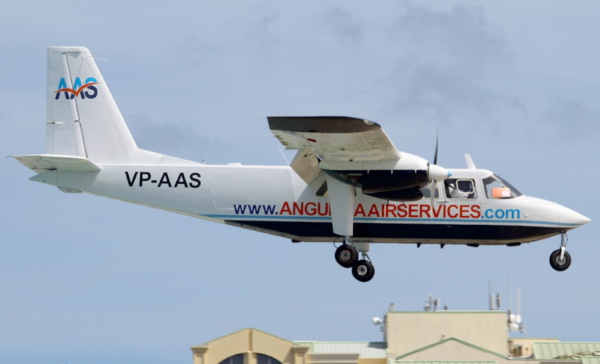
* In the early 1950s, John Britten and Desmond Norman, two British aviation enthusiasts, built and flew the "BN-1", an ultralight single-seat parasol monoplane, powered by a Lycoming O-145 flat-four air-cooled piston engine. It was a tiny aircraft -- with a length of only 5.06 meters (16 feet 7 inches) and a weight of 285 kilograms (630 pounds) -- and never went into production.
However, the collaborative effort led the two men to form the Britten-Norman firm in 1953, the company being focused on crop spraying at the outset, along with any other such aviation work as the company could find. Britten and Norman still wanted to build aircraft, and so in 1963 the firm began development of a twin-piston commuter-utility aircraft, with the initial prototype of the "BN-2 Islander" conducting its first flight on 13 June 1965. The first prototype appeared at the Paris Air Show four days later. A second prototype took to the air on 20 August 1965; the first production machine performed its initial flight on 24 April 1967, with US and UK certification by the end of that year.
The Islander was, in effect, a follow-on to the venerable de Havilland Dragon Rapide biplane small transport, which had put in several decades of reliable, if not notably speedy, service in Britain and elsewhere. Customers wanted an aircraft with good capacity and low operating costs, performance being a secondary consideration. The Islander accordingly had an excellent payload-to-weight ratio, and was designed to be easy to manufacture, as well as very strong. It was originally to have a fabric-&-steel airframe -- but by the 1960s that was a generally outmoded concept, and it ended up being of light-alloy monocoque construction.
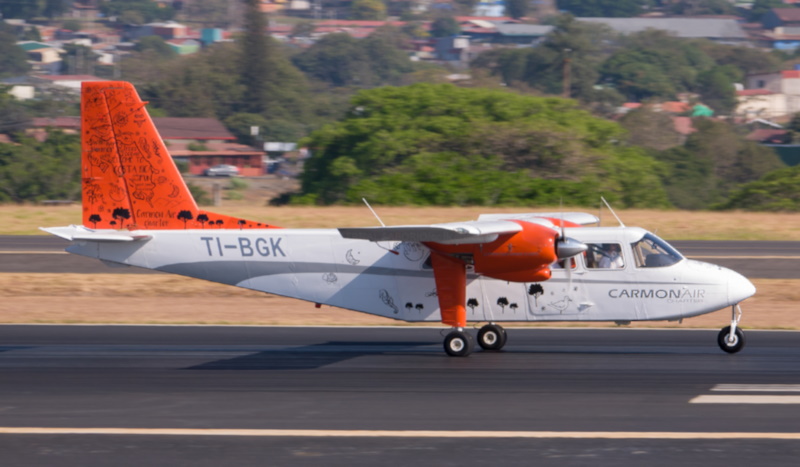
The Islander was a high-wing cantilever monoplane, with no wing bracing; a conventional tail assembly; a fuselage featuring a rectangular cross-section; and an engine on each wing. The two-spar wings and the tailplane were of rectangular configuration, both flat with no dihedral, the wings having an incidence of two degrees and featuring flared-up tips. The first prototype originally had wings with a span 1.22 meters (4 feet) shorter than production aircraft.
The tailfin had a swept leading edge and a small forward fillet. Flight control surfaces were conventional -- ailerons, large one-piece slotted flaps, rudder, elevators, all manually controlled except for electrically-driven flaps. There was a ground-adjustable trim tab in the right aileron, plus trim tabs on the rudder and elevators. De-icing boots were available as an option for all flight surfaces; electrical de-icing for the windscreen and props were also available as options. Incidentally, the Islander didn't have a pneumatic or a hydraulic system.
The first prototype was originally powered by two Rolls-Royce Continental IO-360B flat-six air-cooled piston engines with 155 kW (210 HP) each. They were then replaced by more powerful Lycoming O-540-E4 flat-six engines with 195 kW (260 HP) each, located further outboard on the wings, for better engine-out handling, the O-540-E4 engines being retained in production. They drove two-blade feathering metal Hartzell props. There was an integral fuel tank in each wing outboard of the engine, each with its own refueling point, total fuel capacity being 505 liters (133 US gallons).
The Islander had fixed tricycle landing gear, the steerable nose gear having a single wheel; the main gear having twin wheels, mounted on a strut with a streamlined fairing extending from each engine nacelle. The nose and main gear used the same size of tires; all gear assemblies were shock-absorbed. The Islander could operate from unimproved airstrips, and had excellent short-field capability -- indeed, in 1968 an Islander landed and took off from the carrier HMS HERMES, without use of arresting cable or catapult. Wheel-ski landing gear was eventually offered; floats could be fitted as well, though the lack of photos of Islanders with floats suggests that was an unusual configuration.
Typical operating configuration was a single pilot and nine passengers. There was no center aisle, all passenger seats being of bench configuration; access to the cabin was by three front-hinged doors, one on each side of the forward fuselage, one behind the wing on the left side, with the seat backs tipping forward for access. Door windows could be pushed out for emergency exit. Baggage was stowed in the rear of the cabin.
The interior could be quickly reconfigured for freight hauling, the seats being stowed in the rear. The Islander could also operate as an air ambulance, hauling two stretchers and attendants; a parachute aircraft, with eight parachutists and a jumpmaster, with a sliding door on the left that could be opened in flight; or a photographic / geophysical / environmental survey aircraft. Executive / VIP configurations were available as per customer request. Not surprising given Britten-Norman's agricultural aircraft work, the Islander could also be fitted with aerial spray gear. Avionics were standard for light civil aircraft of the era -- radio, navaids, and so on. The Islander was unpressurized and not climate-conditioned; even the cabin heater was optional. An oxygen system was another option.
* Production of the Islander started out at the Britten-Norman factory at Bembridge on the Isle of Wight, but demand for the Islander gradually outstripped its production capacity. Britten-Norman accordingly placed a contract with Intreprinderea de Reparatii Material Aeronautic (IRMA) of Romania, initially to produce subassembly kits, which were shipped to the UK for completion. IRMA then moved on to assembling the aircraft themselves, with the first Romanian-assembled Islander performing its initial flight in August 1969. The major share of Islander production was in Romania.
An improved version, the "BN-2A Islander" -- originally the "BN-2 Series 2" -- conducted its initial flight in 1969. It featured aerodynamic and flight equipment improvements, such as lower-drag engine cowlings and undercarriage, an improved interior, an enlarged rear baggage area with an external access door on the left side of the fuselage, plus an intercom and other niceties.
___________________________________________________________________
BRITTEN-NORMAN BN-2A ISLANDER:
___________________________________________________________________
wingspan:
14.94 meters (49 feet)
wing area:
30.19 sq_meters (325 sq_feet)
length:
10.86 meters (35 feet 8 inches)
height:
4.18 meters (13 feet 9 inches)
empty weight:
1,640 kilograms (3,610 pounds)
MTO weight:
2,995 kilograms (6,600 pounds)
max cruise speed:
255 KPH (160 MPH / 140 KT)
service ceiling:
4,450 meters (14,600 feet)
range (economical cruise speed):
1,400 kilometers (870 MI / 755 NMI)
take-off run (to 15 meters / 50 feet):
332 meters (1,090 feet)
landing run (from 15 meters / 50 feet):
290 meters (960 feet)
___________________________________________________________________
From 1970, other options were added:
Financial difficulties led to Britten-Norman going broke in October 1971. The company was rescued by the Fairey Aviation group, which bought out Britten-Norman in August 1972, forming the Fairey Britten-Norman company, with most UK manufacturing transferred to the Fairey factory in Gosselies, Belgium. From 1974, a number of Islanders were assembled in the Philippines. In 1977, a single standard BN-2 was re-engined with Dowty-Rotol ducted fans, powered by piston engines, the goal being to reduce noise. The ducted fans proved effective, but that configuration did not go into production.
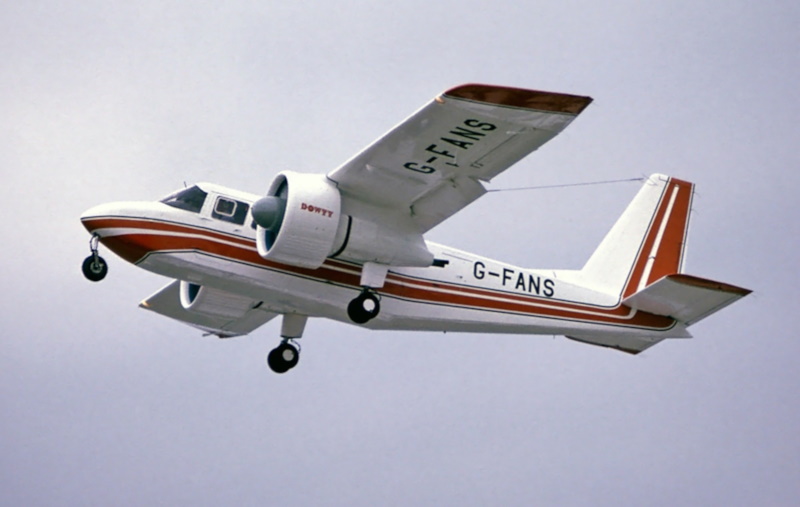
The next year, 1978, a further refined production version, the "BN-2B Islander II", was introduced as the result of a product improvement program. The BN-2B featured higher maximum weight, a redesigned cockpit and interior, plus lower cabin noise levels. In that year, Britten-Norman was purchased by Oerlikon-Buehrle of Switzerland, parent company of the Swiss Pilatus aircraft firm, the result formally becoming "Pilatus Britten-Norman".
Following earlier experiments with Lycoming LTP101 turboprop engines, Britten-Norman introduced the "BN-2T Turbine Islander" in 1980, powered by twin Allison -- now Rolls-Royce Allison -- 250-B17C turboprop engines with 300 kW (400 SHP) each, driving Hartzell three-bladed variable-pitch metal propellers. Other than a wing fence on each wing outboard of mid-span, the BN-2T was otherwise largely identical to the BN-2B, with the same options for kit.
Seven were obtained in 1989:1990 by the British Army Air Corps as the "Islander AL1", most or all being fitted with an electro-optic / infrared (EO-IR) imaging turret, with at least two being painted in "desert pink" and participating in the First Gulf War. Other government users included the Belgian Gendarmarie, Malta, and Netherlands Police; as well as the coastal patrol organizations of Mauritius, Morocco, and Pakistan.
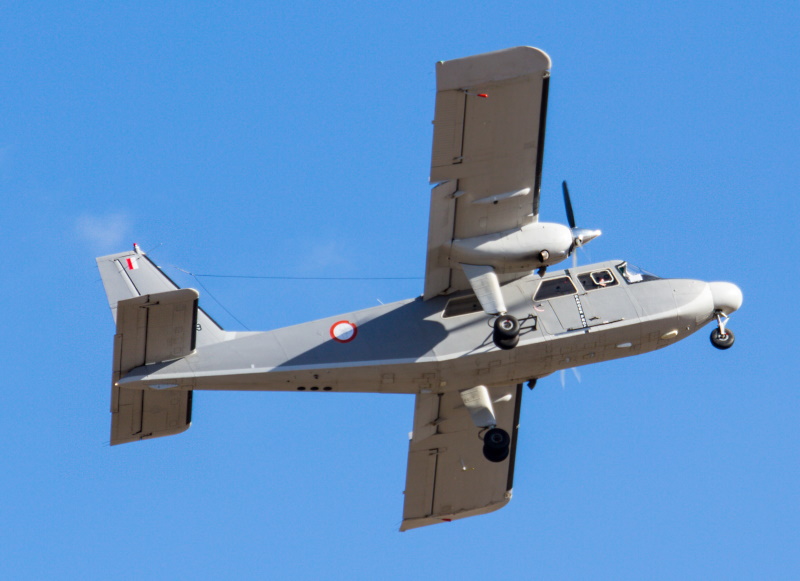
Pilatus sold off Britten-Norman in 1998, with the company then being sold off again to Omani investors in 2000, the result being the "Britten-Norman Group (BNG)" -- a cluster of firms, performing aircraft production as always, but also aircraft assembly subcontracting, sensor systems integration, and flight services. Although the group did acquire Romaero, the Romanian manufacturer of the Islander, all production was transferred back to the UK in 2010.
About 1,300 Islanders have been built; trying to itemize all users would be troublesome, the type having been obtained by at least 120 countries. It appears to have been particularly popular in Africa and other parts of the developing world. Modern versions have been offered with a range of options -- not only interiors at varying levels of luxury, along with in-flight entertainment systems, but also enlarged doors, 3-bladed scimitar propellers, and low-drag fairings.
Underwing pylons could also be installed for carrying pods, spray booms, and other external stores. The Islander being very sturdy, older machines remain in service, with Britten-Norman providing refurbishment and upgrades to digital "glass cockpits", and other modernized avionics or kit. There is work in progress to convert an Islander to hybrid-electric power under Project Fresson, which is a collaboration between Britten-Norman and Cranfield Aerospace -- which is the commercial arm of Britain's Cranfield University, a leader in aerospace education and research. The hybrid Islander will use a hydrogen fuel cell system for power. Initial flight is expected in 2025.
BACK_TO_TOP* The rugged construction of the Islander made it suitable for military, paramilitary, or police use. While stock Islanders were obtained for service use, Britten-Norman also introduced a lightly militarized version, the "Defender"; it made its initial flight in 1970, with introduction to service in 1971.
The Defender was generally similar to the Islander, with much the same options, including choice of piston or turbine engines, the cabin generally being fitted for utility use. The most visible difference was four stores pylons -- each inboard pylon with a load capacity of 320 kilograms (700 pounds) and each outboard pylon with a load capacity of 205 kilograms (450 pounds). Stores included bombs, rocket pods, machine-gun / cannon pods, illumination flares, or 227-liter (60 US gallon) external tanks. The Defender could also be obtained with militarized avionics, including defensive countermeasures systems.
A "Maritime Defender" ocean-patrol version, with a search radar in the nose, was sold as well. Options for the Maritime Defender included an underwing searchlight, rescue kits with inflatable dinghys, or maritime offensive stores. Other specialized variants of the Defender were flown or considered as well:
The Islander / Defender proved popular with military, paramilitary, and police organizations of developing countries. Users included Abu Dhabi, Belgium, Belize, Botswana, Ghana, Guyana, Hong Kong, Iraq, India, Oman, Panama, Philippines, Malawi, Malgasy, Mauritania, Rwanda, Seychelles, Surinam, and the UK. The US Federal Bureau of Investigation also flew at least one Defender as a surveillance platform, using it during the siege of the Branch Davidian cult compound near Waco, Texas, in 1993.
It appears the Defender was generally used in the utility or patrol roles -- but it did get into shooting matches on occasion. Armed Defenders saw combat with the Mauritanian Air Force, six being used against Polisario insurgents in the Western Sahara in 1976, two being lost; and with the Royal Cambodian Air Force, three being used against Khmer Rouge insurgents in 1993, one being lost. On the flip side, a Botswanan Defense Forces Islander was shot down by a cannon-armed Rhodesian Alouette helicopter in 1979.
The British Army Air Corps, having earlier obtained seven Islander AL1s, then obtained three "Defender AL1" in 2004:2005 for the operations following the Second Gulf War, with five Defender AL1s and one "Defender T3" trainer delivered in 2007:2011. Like the Islanders, they were equipped with an EO-IR turret and other sensor kit. Along with foreign service, these 16 aircraft were used for domestic security, including operations over Northern Ireland, as well as to deal with human trafficking over the English Channel.
One of the Islanders was damaged beyond repair in an accident, three were mothballed, and the other three were redesignated "Islander R1" in 2019, with the Defenders similarly redesignated "Defender R1" at that time -- and also transferred to RAF control. The last of the fleet was retired in 2021, with the nine Defenders sold back to Britten-Norman for refurbishment and resale.
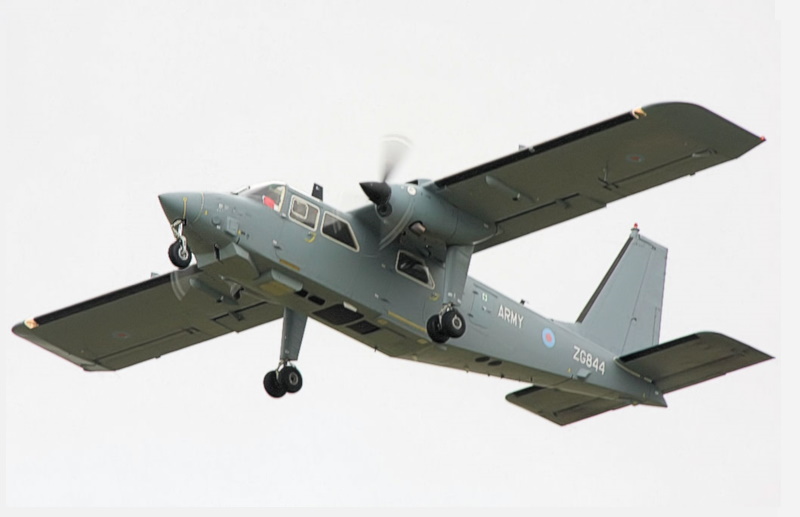
* Pilatus Britten-Norman flew a stretched version of the Defender, the "BN2T-4S Defender 4000", with initial flight of the prototype on 17 August 1994, and introduction to service in 1997. It featured a fuselage extended by 76 centimeters (2 feet 6 inches) forward of the wing; and it had the wide-span wings of the Trislander, see below, plus an enlarged tailplane and tailfin. It was powered by Rolls-Royce / Allison 250-B17F/1 turboprops with 300 kW (400 SHP) each, driving three-bladed variable-pitch propellers. The undercarriage was reinforced to handle higher take-off weights. It was otherwise similar to the original Defender, with two hardpoints under each wing for carriage of stores.
___________________________________________________________________
BRITTEN-NORMAN BN2T-4S-2A ISLANDER:
___________________________________________________________________
wingspan:
16.15 meters (53 feet)
wing area:
32.61 sq_meters (351 sq_feet)
length:
12.2 meters (40 feet)
height:
4.36 meters (14 feet 4 inches)
empty weight:
2,225 kilograms (4,900 pounds)
MTO weight:
3,855 kilograms (8,500 pounds)
max cruise speed:
285 KPH (175 MPH / 155 KT)
service ceiling:
7,620 meters (25,000 feet)
range (economical cruise speed):
1,400 kilometers (990 miles / 860 NMI)
take-off run (to 15 meters / 50 feet):
565 meters (1,855 feet)
landing run (from 15 meters / 50 feet):
589 meters (1,935 feet)
___________________________________________________________________
The Defender 4000 could be fitted with weather or search radar in the nose, or with an imaging turret under the nose; cameras could be fitted through ports in the doors or the floor, and bubble windows for visual observations were also available as an option. It could carry up to 16 troops or passengers in a tactical transport configuration, or a dozen in a more comfortable arrangement. Options included sliding seat rails that permitted flexible interior arrangements, a sliding door, and cargo tie-downs,
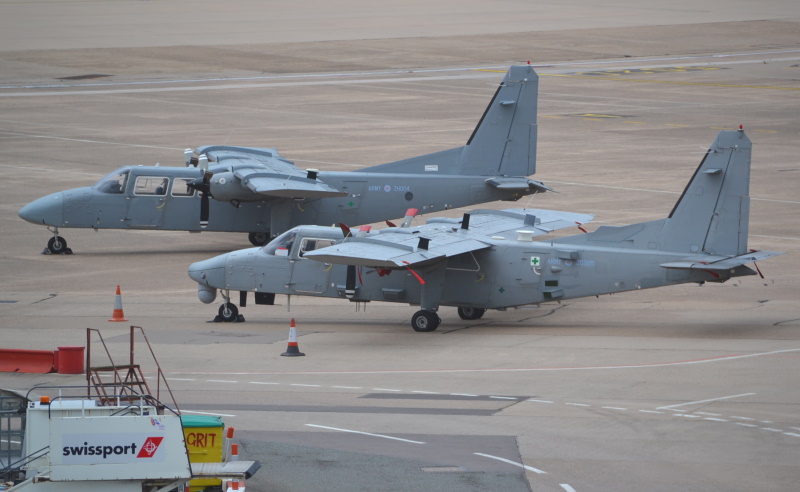
The Defender 4000's primary focus was on carriage of sensor and instrument payloads for paramilitary, police, or other government organizations. It was introduced into service with the Irish Air Corps in 1997, one being obtained. Only about a dozen were built in all, with eight for the British Army Air Corps being obtained from 2003, it appears for operations in Iraq. Four AAC machines were obtained in "Defender AL1" configuration, featuring an undernose imaging turret and defensive countermeasures; they were followed by three improved "Defender AL2" machines, with an AL1 updated to AL2 configuration as well, plus a single "Defender T3" trainer. All the AAC Defenders were transferred to the RAF in 2019.
A few British police organizations have obtained the Defender 4000 as well, with a handful sold to other users. It appears it's still on offer, but there's not much sales activity.
BACK_TO_TOP* In 1968, the second Islander prototype was re-used for a further development program, being modified into a stretched aircraft with greater capacity, known as the "Super Islander". That effort bogged down and went nowhere; on rethinking things, that aircraft was rebuilt as the three-engine "BN-2A Mark III Trislander", which performed its first flight on 11 September 1970 -- appearing at the Farnborough Air Show that same day.
The Trislander featured a fuselage stretch of 2.48 meters (8 feet 2 inches), to 13.34 meters (43 feet 9 inches); that demanded more engine power, meaning a third IO-540-E4 engine, which was mounted midway up an enlarged tailfin, with the tailplane mounted on the rear of the engine fairing. The landing gear, though of the same configuration as that of the Islander, was also reinforced to handle greater take-off weight, and featured bigger tires.
The Trislander could carry a pilot and 17 passengers on bench seats, again with no center aisle; access was through five front-hinged doors, two on the left side of the fuselage, three on the right, the seats tipping forward. Heating and ventilation were standard fit; it is unclear if air conditioning was an option. There was a baggage hold in the back, with a door on the left side of the fuselage. Emergency exit was through pop-out windows on the front four doors. The Trislander could be quick-changed to a cargo configuration; VIP and air ambulance configurations were available on customer request.
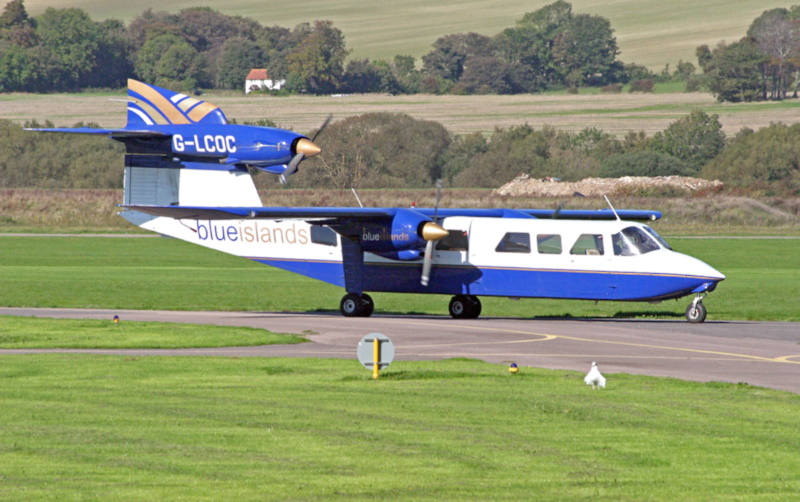
The cockpit dashboard layout, in the days before glass cockpits, proved challenging, since it meant cramming in support for a third engine when the dashboard was the same size as that of the Islander. The Trislander had raked wingtips, with the wingtip tanks, and also a tailplane with raked wingtips. Fuel capacity was 700 liters (185 US gallons). De-icing gear and dual controls were optional, as was the extended nose with baggage hold. Machines with the extended nose were designated "Mark III-2", the baseline machine being, of course, the "Mark III-1". There was also a "Mark III-3" that had an automatic prop feathering system on engine failure, and a "Mark III-4" with a rocket booster. It doesn't appear there was ever any serious consideration of a turboprop Trislander, though it would have been interesting.
___________________________________________________________________
BRITTEN-NORMAN BN-2A MARK III TRISLANDER:
___________________________________________________________________
wingspan:
16.15 meters (53 feet)
wing area:
31.31 sq_meters (337 sq_feet)
length (long nose):
14.48 meters (47 feet 6 inches)
height:
4.32 meters (14 feet 2 inches)
empty weight:
2,650 kilograms (5,485 pounds)
MTO weight:
4,535 kilograms (10,000 pounds)
max cruise speed:
265 KPH (165 MPH / 145 KT)
service ceiling:
4,010 meters (13,150 feet)
range (economical cruise speed):
1,610 kilometers (1,000 MI / 870 NMI)
take-off run (to 15 meters / 50 feet):
595 meters (1,950 feet)
landing run (from 15 meters / 50 feet):
440 meters (1,445 feet)
___________________________________________________________________
Initial customer deliveries were in 1971. Trislanders were built on the Isle of Wight, and also by Romaero. The Trislander was not greatly successful, possibly because it was so unconventional, production ending in 1982 after only 82 had been built. It appears that some of the early production were conversions of Islanders. Pilatus Britten-Norman did negotiate with the International Aviation Corporation (IAC) of Florida to license-build the Trislander, but that came to nothing.
* Along with the Trislander, in the late 1960s Desmond Norman designed an all-metal four-seat touring aircraft, the "BN-3 Nymph", which performed its first flight on 17 May 1969. It was roughly in the class of the popular Cessna 172, having a high braced wing -- the flight surfaces had a clear resemblance to those of the Islander -- along with fixed tricycle landing gear; plus a Lycoming O-235 flat-four air-cooled engine, providing 85 kW (115 HP), driving a two-blade variable-pitch propeller.
The wing bracing was of "Y" configuration for added strength, and there was an extensible bumper wheel under the tail. The doors on either side of the cockpit were forward-hinged. The Nymph had a span of 11.98 meters (39 feet 4 inches), a length of 7.2 meters (23 feet 7 inches), and an empty weight of 515 kilograms (1,140 pounds). The wide span gave it a heavy lifting capability for its class and good short-field performance, at some penalty in speed.
The Nymph was envisioned as a kitbuilt of sorts, with assemblies to be provided to firms in developing countries for assembly and sale. There wasn't a lot of interest, and the Nymph remained a one-off, until Norman set up a new company named "NDN" in 1976 -- his full name was "Nigel Desmond Norman", by the way. The prime focus of the company was to build the "NDN-1 Firecracker", a sleek tandem-seat trainer with retractable tricycle landing gear and a Lycoming O-540 flat-four engine.
Refit with a Pratt & Whitney Canada (PWC) PT6A turboprop led to the "NDN-1T Turbo Firecracker", with three built. It was offered for an RAF requirement for a trainer, but the service opted for the Shorts Tucano instead, and that was the end of the Firecracker. Norman also developed a PT6A-powered agricultural aircraft, the "NDN-6 Fieldmaster", but only six were built.
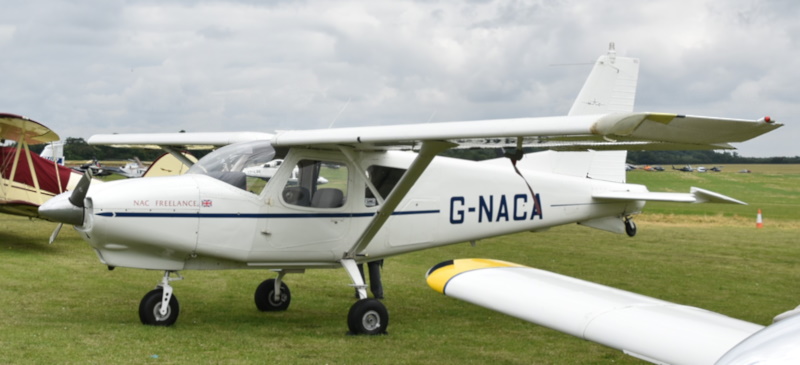
While working on these projects, Norman decided to revive the Nymph, rebuilding it with a bigger cabin, the aircraft flying for the first time in its new configuration on 29 September 1984, under the name of "NAC-1 Freelance" -- the company name having been changed to "Norman Aircraft Corporation" by that time. Assemblies for six production aircraft were built, but none of these were ever flown, with NAC going broke in 1988. There have been various attempts since that time to put the NDN / NAC aircraft into production, but they've come to nothing.
BACK_TO_TOP* The Short Brothers aircraft firm of Belfast, Northern Ireland, had been in business long before the formation of Britten-Norman, being noted particularly for flying boats -- including the famous "Sunderland" of World War II. In 1958, representatives of the Miles aircraft firm approached Short officials to obtain backing for development of a twin-engine transport aircraft.
From 1945, Miles had produced 52 examples of a small transport aircraft, the "M.57 Aerovan", which was essentially a pod made mostly of plastic-bonded plywood, featuring a high wing with twin piston engines, a triple-fin tail on a boom, and fixed tricycle landing gear. Miles wanted to develop a follow-on named the "Caravan", but Shorts officials decided they weren't interested in helping out.
They were, however, inspired to develop their own transport aircraft, with the initial prototype of "Shorts SC.7 Skyvan" performing its initial flight on 17 January 1963. The "Series 1" prototype was initially powered by twin Continental GTSIO-520 flat-six air-cooled engines with 290 kW (390 HP) each; to be quickly re-engined with Turbomeca Astazou II turboprop engines, providing 388 kW (520 SHP) each. The "Series 1A", as the re-engined prototype was designated, performed its first flight with the turboprop engines on 2 October 1963.
Production was initiated in 1964; following construction of three "Series 2" pre-production machines with Astazou XII engines providing in principle 515 kW (690 SHP) each, the Skyvan entered service in 1965. Only 19 Series 2 machines, including the three pre-production aircraft, were built. The Astazou XII only achieved about 90% of its rated power in practice; the Skyvan 2 was simply underpowered, particularly for "hot & high" (hot weather, high ground) operation.
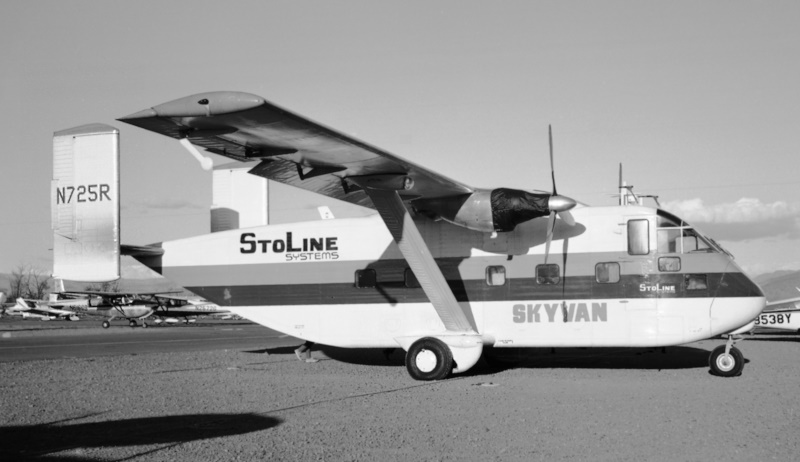
That led to a search for a more satisfactory engine, Short settling on the Garrett AiResearch TPE331-201 turboprop with 535 kW (715 SHP) each. Two Series 2 Skyvans were converted to TPE331 powerplants. They proved much more satisfactory, with the TPE331-powered "Series 3" entering production in 1968.
* The Skyvan 3 provides a baseline for the family. The Skyvan owed nothing much in particular to the Miles Aerovan except inspiration. Conceptually, the Skyvan was along the same lines as the Islander -- simple, utilitarian, unpressurized, fixed landing gear, high braced wing, and twin engines. It was, however, well bigger, with about twice the empty weight.
The Skyvan was useful, but not at all pretty; it was said not to really be able to fly, it was just so ugly that the Earth rejected it. It was of all-metal construction, featuring:
The wing had a slight dihedral outboard of the engines. Flight control surface arrangement was conventional, with ailerons, single slotted flaps, ailerons, rudders, plus trim tabs. De-icing for the leading edges of the wings and tailplane was available as an option; the de-icing scheme was described as "sintered metal", apparently being a grit-sandpaper-like surface that passively resisted the buildup of ice. Skis could be fitted for operations in winter environments; low-pressure tires were also an option, for rough-field operations.
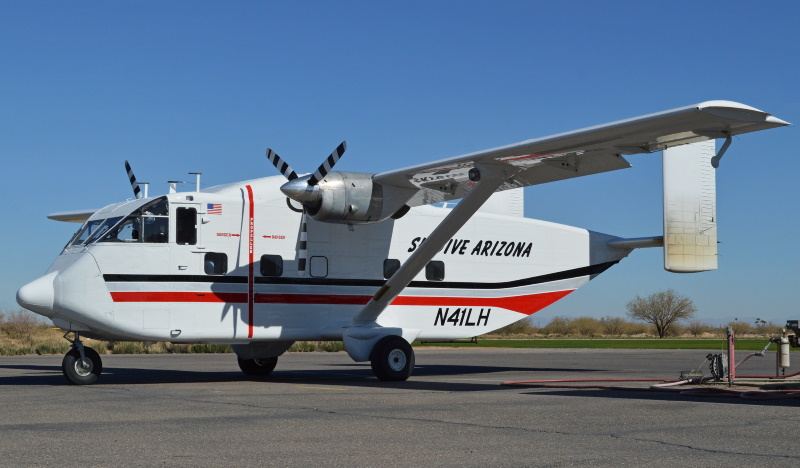
The TPE331-201 engines drove 3-bladed Hartzell variable props. All fuel was in four tanks in the wing center section. In early Series 2 production, total fuel capacity was 796 liters (210 US gallons), increased to 1,024 liters (270 US gallons). For the Series 3, total capacity was 1,332 liters (351 US gallons); four tanks could be optionally fitted into fuselage frames beneath the main tank to bring fuel capacity up to 1,773 liters (468 US gallons). It was unclear how many refueling points there were, and where they were located.
___________________________________________________________________
SHORT SKYVAN 3:
___________________________________________________________________
wingspan:
19.79 meters (64 feet 11 inches)
wing area:
34.65 sq_meters (373 sq_feet)
length:
17.69 meters (40 feet 1 inch)
height:
4.6 meters (15 feet 1 inch)
empty weight:
3,320 kilograms (7,315 pounds)
MTO weight:
5,760 kilograms (12,500 pounds)
max speed at altitude:
315 KPH (195 MPH / 160 KT)
cruise speed:
280 KPH (175 MPH / 150 KT)
service ceiling:
6,860 meters (22,500 feet)
range:
1,115 kilometers (695 MI / 600 NMI)
take-off run (to 15 meters / 50 feet):
610 meters (2,000 feet)
landing run:
622 meters (2,040 feet)
___________________________________________________________________
The Skyvan could haul cargoes weighing up to 2,085 kilograms (4,600 pounds), with a roller floor available as an option. It was designed to be flown by a single pilot, though a copilot could be accommodated as well. It could carry up to 19 passengers, or in a medevac role 12 stretchers along with attendants. The big rear door made it an excellent parajumping aircraft. A VIP interior was available, with accommodations for nine passengers. Avionics were typical for a commercial machine of the era -- radio, navigation aids, transponder -- with weather radar, in a pimple nose, and autopilot optional.
In service, the Skyvan was called the "Flying Shoebox" or the "Shed". Although no beauty queen or speed racer, it was effective and said to be fun to fly. Later variants included:
There was also a "Skyliner", which was a dedicated airliner variant; it could carry 19 or 22 passengers, with a toilet, galley, and airstair door optional.
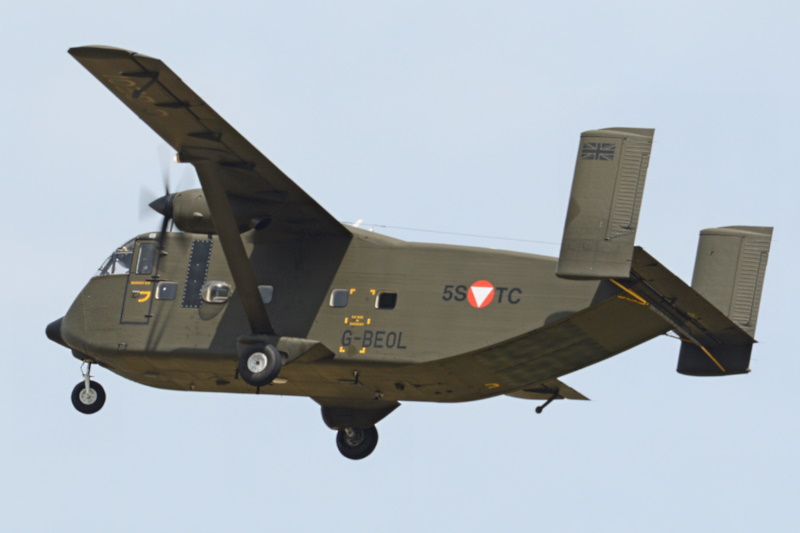
The Skyvan was flown by both civil and military / paramilitary operators, being flown in government service by Argentina, Austria, Botswana, Ghana, Guyana, Ecuador, Indonesia, Lesotho, Malawi, Mauritania, Nepal, Oman, Panama, Singapore, and Thailand. The Skyvan lingered in service until after the end of the century. Total number of Skyvans built to end of production in 1986, including the prototypes, was 153 machines, including 60 Series 3M military machines. It was not highly successful, not being in the "sweet spot" for a utility aircraft -- too small; not big enough.
BACK_TO_TOP* Following up on the Skyliner version of the Skyvan, Short Brothers went on to build a Skyvan-derived airliner, with the initial flight of the first of two prototypes of the "Short 330" on 22 August 1974. The initial Short 330-100 version entered service in 1976.
The Short 330 was basically a stretched Skyvan, with a wider wingspan and a more conventional front-end configuration. It had retractable tricycle landing gear provided by Menasco, all assemblies with single wheels, the nose gear retracting backward, the main gear retracting up into pods at the base of the wing bracing. It was powered by PWC PT6A-45A/B turboprops with 760 kW (1,020 SHP) continuous each, driving five-bladed metal Hartzell propellers. The engine inlets and props were de-iced, it appears electrically. All fuel was in integral tanks in the wing center section / upper fuselage fairing above the passenger compartment, with initial capacity being 2,182 liters (576 US gallons), later increased to 2,546 liters (671 US gallons). The Short 330 featured single-point refueling.
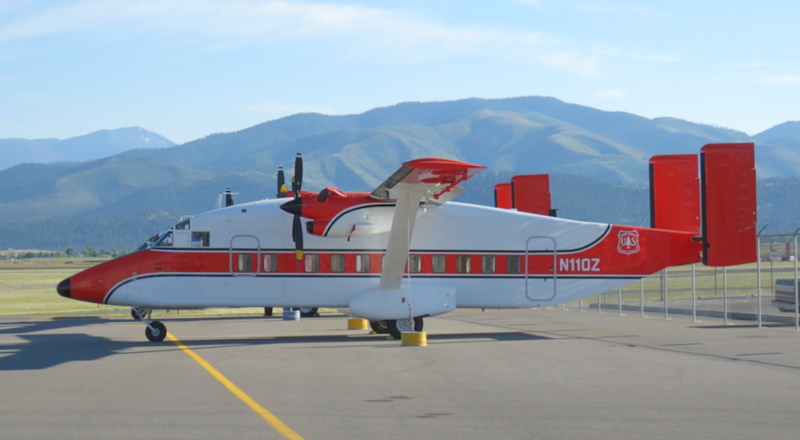
Flight surface arrangement was much like that of the Skyvan -- three-piece flaps; ailerons; elevators; twin tailfins with rudders, plus trim tabs. All flight control surfaces were manually actuated, except for hydraulic flaps. De-icing boots on the leading edges of the flight surfaces were optional.
The aircraft could carry 30 passengers -- in rows of three seats, one on the left, two on the right. The interior was designed with assistance from Boeing. Galley and toilet were standard, as was air conditioning. Passenger and crew access to the aircraft was through a forward-hinged door on the left rear, with a matching service door / emergency exit on the right rear. There were emergency exits on both sides of the front fuselage -- the left emergency exit was inset into a forward-hinged cargo door -- plus an escape hatch on top of the cockpit. There was a baggage compartment in the nose, with an upward-hinged door on the left. Unconventionally, there were separate doors to the cockpit for the pilot and copilot. Avionics were typical for an airliner of the era, including weather radar.
Although still not all that stylish and no speed demon, the Short 330 was reliable and inexpensive to operate. It also inherited the Skyvan's excellent short-field capability, allowing the 330 to operate out of small airports.
The Short 330 was available in a cargo variant, the "330C", with a roller floor. It was also available in a "330 Combi" variant, with a cargo compartment forward, and seating for 18 passengers in the rear. It could be "quick changed" to an all-cargo or all-passenger configuration. The -100 variant was followed by the "Short 330-200" variant, with minor improvements and uprated PWC PT6A-45R engines.
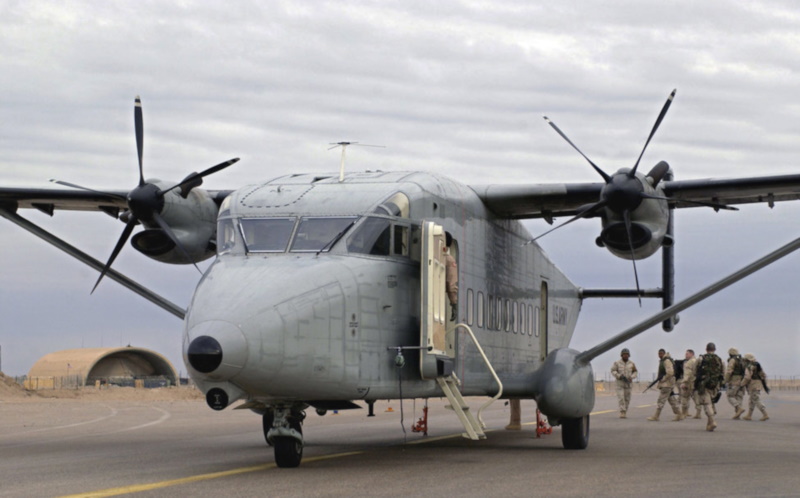
Short sold a military "utility tactical transport" version, the "Short 330-UTT", with a reinforced cabin floor and paratroop doors. Not many were sold, the biggest buyer being the Thais, who bought four. The "Short Sherpa" was an air freighter with a rear cargo door / ramp, the initial flight being on 23 December 1982.
It was more popular, with the USAF ordering 18 in 1984, these machines being used for parts distribution in Europe, lacking windows and featuring the optional roller floor. Sherpas were also obtained by the US Army. They were designated "C-23A" in USAF service. They had been phased out by 1990, with three to the Test Pilot's School at Edwards Air Force Base in California; seven to the US Forest Service; and eight to the US Army.
The Army also obtained a total of 16 Sherpas, these machines with windows and being designated "C-23B" -- the USAF C-23As handed down to the Army may have been redesignated "C-23B" as well. They were used for Army National Guard aircraft parts distribution. In addition, the Army used four Short 330s, bought used, to be configured as range control aircraft on the Kwajalein Missile Range in the Pacific; they were not given a military designation.
___________________________________________________________________
SHORT 330-200:
___________________________________________________________________
wingspan:
22.76 meters (74 feet 8 inches)
wing area:
42.1 sq_meters (453 sq_feet)
length:
17.69 meters (58 feet)
height:
4.95 meters (16 feet 3 inches)
empty weight:
6,680 kilograms (14,725 pounds)
MTO weight:
10,385 kilograms (22,900 pounds)
max speed at altitude:
455 KPH (280 MPH / 245 KT)
cruise speed:
350 KPH (220 MPH / 190 KT)
service ceiling:
6,400 meters (26,000 feet)
range:
1,695 kilometers (1,055 MI / 915 NMI)
take-off run (to 15 meters / 50 feet):
1,042 meters (3,420 feet)
landing run (from 15 meters / 50 feet):
1,262 meters (4,140 feet)
___________________________________________________________________
The 360-200 was followed in turn in 1987 by the "360-300", with more powerful PT6A-67R engines, providing 1,060 kW (1,424 SHP) each, driving six-blade Hartzell propellers, plus redesigned wing struts and engine nacelles for increased cruise speed. A "360-300F" freighter variant was also introduced, with an enlarged cargo door, a roller floor, and capacity for five LD3 cargo containers.
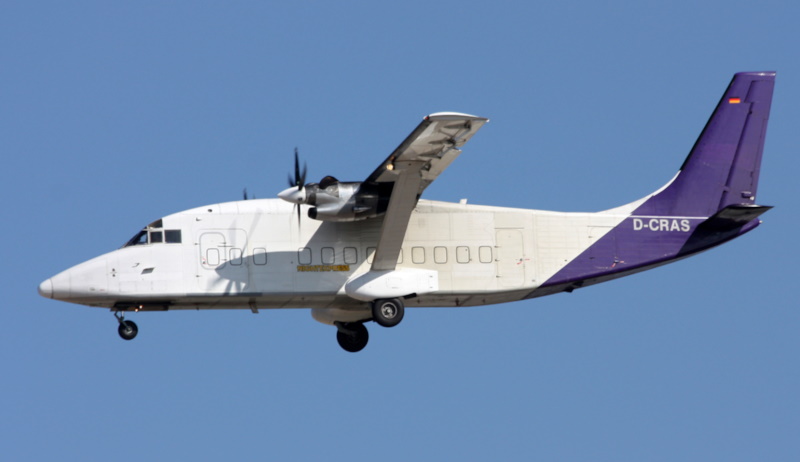
The US military obtained 28 used Short 360s as the "C-23B+", these machines being uniquely refitted with the rear fuselage and twin tail of the 330-based Sherpa. The fleet of C-23B and C-23B+ machines was updated with new avionics, to be redesignated "C-23C". The Sherpas served as intra-theater haulers in Iraq. A program was set up to further upgrade C-23 avionics to "C-23D" standard, but only four upgrades were performed before the C-23 fleet was retired in 2014, some of the aircraft being passed on to other users. Brazil obtained four in 2016 and four more in 2018, these aircraft being refurbished and given updated avionics.
The Army also obtained seven used Short 360s, refitting them with surveillance gear for use in Iraq under the CONSTANT HAWK program. They were not given a military designation; two were lost in a mid-air collision before they reached the combat theater. Production of the Short 360 ended in 1991, after 164 deliveries to customers. Its simplicity was its downfall: it couldn't compete with pressurized airliners in the same class, with better performance. The Short 360 lingers in service in the present day.
BACK_TO_TOP* The Britten-Norman firm also worked on hovercraft, seeing them as useful for transport in undeveloped nations where roads were poor and the rivers sometimes too shallow to be navigable. The result was the formation of the spinoff Cushioncraft firm in 1960, which developed a series of hovercraft; it was bought out by the British Hovercraft Corporation in 1972. There's obviously an interesting story here, but details are scarce, and it's beyond the scope of this document anyway.
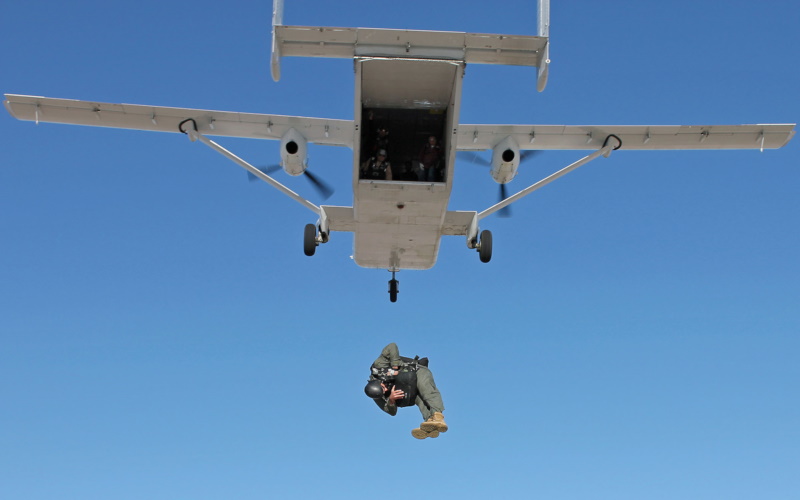
Sources for this document included volumes of JANE'S ALL THE WORLD'S AIRCRAFT back to the 1970s, plus whatever I could scrounge up off the internet. These machines are not over-documented.
* Illustrations credits:
* Revision history:
v1.0.0 / 01 oct 17 v1.0.1 / 01 sep 19 / Review, update, & polish. v1.0.2 / 01 jul 21 / Review, update, & polish. v1.0.3 / 01 jun 23 / Review, update, & polish. v1.0.4 / 01 jun 25 / Review & polish.BACK_TO_TOP
